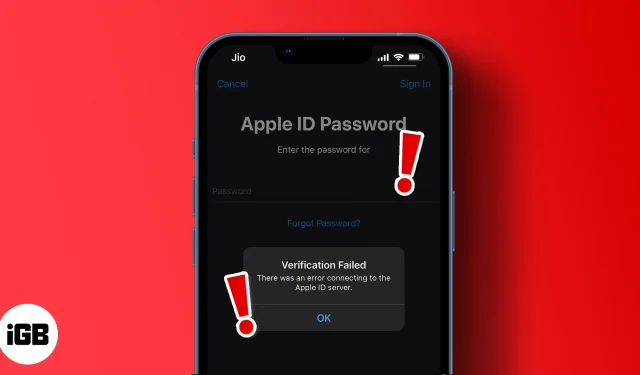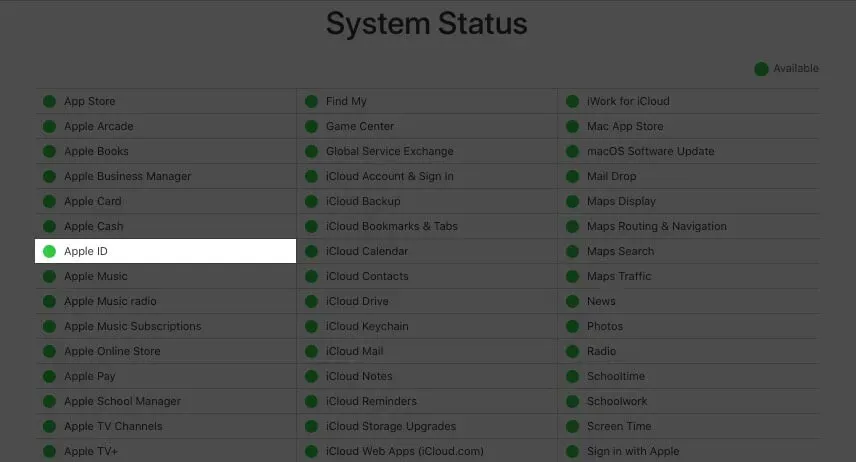How to fix Apple ID verification error on iPhone and iPad

Some iPhone errors can prevent you from accessing the main features of your iPhone. And it’s frustrating! The inability to connect to the Apple ID server is one such annoying error.
If Verification Failed, you won’t be able to install apps, stream Apple Music, or sign in to apps with your Apple ID. I understand that the damage can be extensive. But don’t worry. You are not alone. The following solutions are proven ways to fix the validation failure error and revive your Apple ID from the Apple server.
- Check your router and mobile data connection
- Turn Airplane Mode Off and On
- Force restart your iPhone
- Check Apple System Status
- Update your software version
- Update date and time settings
- Reset network settings
- Deactivate third-party VPNs and proxies
- Reset your iPhone
- Contact Apple Support
1. Check your router and mobile data connection.
After all, the error could be related to a simple internet connection issue. If you’re on a personal Wi-Fi network, the first step to troubleshoot the Apple ID Server Connection Error is to check if your internet router is within range. This includes making sure your iPhone connects to the correct router hotspot.
In addition, your Wi-Fi may have picked up the wrong signal. Generally, you also want to resolve common Wi-Fi issues on your iPhone. To check the router serving your iPhone, go to iPhone Settings → Wi-Fi. Here you will see the hotspot connected to your iPhone. As a quick fix, you can also try turning Wi-Fi off and on to see if it works.
If you’re using a mobile network instead, check to see if your iPhone’s data connection is active. Next, make sure your iPhone is not in Data Saving Mode:
- Go to iPhone Settings → Mobile Data.
- Tap Mobile Data Options.
- Then turn off low data mode.
2. Turn Airplane Mode Off and On
Turning airplane mode off and on on iPhone helps refresh your network and can restore lost connections. Signing in to your Apple ID requires a strong internet connection, which can be lost or weakened.
To turn Airplane Mode on or off, go to your iPhone’s Control Center (swipe down from the top right corner). Then toggle the airplane icon off and on.
3. Force restart your iPhone
Sometimes restarting your iPhone helps solve many problems. So force restarting your iPhone works if you’ve tried for the hundredth time and still can’t connect to the Apple ID server. In addition to resolving connection issues, restarting can help fix the underlying issues that cause the connection to the Apple ID server to fail.
4. Check Apple system status
Checking the health of an Apple system is very important as the problem may be beyond what you can fix. This tells you if any of Apple’s services are down and saves you the stress of beating around the bush and finding a solution that’s out of your control.
Go to the Apple Support system status page : a green dot indicates a running service. However, if you see a yellow or red dot, the problem might be with the Apple server. Unfortunately, there is nothing you can do on your end other than wait for Apple to restore their system. So keep checking. Then try to connect to your Apple ID again after restoring.

5. Update the software version
Outdated software can prevent your iPhone from working properly. And that includes logging into your Apple ID. While it doesn’t make any sense, it works for some people. If you’re running an older version of iOS than 1OS 15, it’s probably time to catch up and update iOS to the latest version.
6. Update date and time settings
iPhone time setting is definitely one of the common causes of Apple ID server connection failure. This can happen if your iPhone uses manual time settings instead of automatic time zone detection.
And like most web servers, there’s no way Apple’s server can determine your time zone if your iPhone’s time settings don’t match your location.
However, make sure your iPhone’s location service is active before setting the time zone for auto-detect. To do this, open “iPhone Settings”→ “Privacy”→ “Location Services”. Then turn on location services.
To change the iPhone’s time zone:
- Open iPhone Settings → General → Data & Time.
- Turn on Install automatically.
- Switching to 24-hour time format sometimes works. Therefore, you can also enable 24-hour mode.
Now try signing in to your Apple ID again to see if it works. If this still doesn’t work, don’t worry. There are a couple more tricks that work.
7. Reset network settings
Resetting the network seems to be the ultimate solution to the causes of any internet-related connection failure. When you reset iPhone’s network, it refreshes your internet connection, including Wi-Fi or mobile data connection.
It also removes all basic VPN settings and previously used networks that may be restricting your Internet connection. Thus, it brings order to your network and can give it a boost. To reset iPhone network settings:
- Go to iPhone Settings → General → Transfer or Reset iPhone.
- Tap “Reset”→ select “Reset network settings”from the options.
- Provide your iPhone passcode to complete the process.
8. Deactivate third-party VPNs and proxies
VPNs and proxy services detect your location, often masking your IP address. Unfortunately, the Apple ID server needs to determine your current location in order to deliver content from the content delivery network (CDN) closest to you.
So using VPN to switch geolocation or masking your IP address with proxy servers invariably hides your iPhone IP address from Apple Server. Therefore, your device may not be able to get your Apple ID information from the server, resulting in a connection failure.
If you need to use a VPN or proxy service, be sure to turn it off before signing into your Apple ID. You can then reactivate it after logging in.
9. Restart your iPhone
So this is usually the final solution when all else has failed. I hope you don’t need to reset your iPhone as this process may be tedious for some. But don’t worry, the reset will not damage your data if you back up your iPhone data to iCloud or to your computer.
After backing up your data, you can reset your iPhone. This process will remove installed apps, saved contacts, notes and photos, and other files. Luckily, you can always restore your backup to restore them all.
10. Contact Apple Support
While other solutions (most notably resetting your iPhone) will often resolve the Apple ID server connection error, you should contact Apple Support if the issue persists. While you may have tried a few things on your end, Apple Support can help you find the root cause of the error and you’ll fix it before you know it.
While I have shown you how to resolve the Apple ID Server Connection Error, keep in mind that no one solution is right for everyone. You may need to try a few of the listed solutions in order to reconnect to the Apple ID server.
Have you solved the problem with connecting to the Apple ID server on your iPhone? What worked for you? Let me know in the comments section below.
Leave a Reply